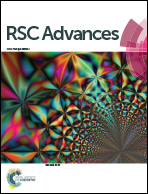Template synthesis of NiO ultrathin nanosheets using polystyrene nanospheres and their electrochromic properties†
Abstract
Ultrathin nickel oxide (NiO) nanosheets with a thickness of ∼10 nm were synthesized by a template method. NiO film was prepared by spin-coating polystyrene@Ni2CO3(OH)2 nanostructures on indium tin oxide (ITO) coated glass and a calcination process. Electrochromic properties of NiO thin film were investigated in an aqueous alkaline electrolyte (1.0 mol L−1 KOH) by means of transmittance and cyclic voltammetry (CV) measurement. The NiO film annealed at 300 °C exhibits noticeable electrochromism with a transmittance modulation of 40.1%, fast coloration and bleaching responses (5.4 and 3.6 s) and high coloration efficiency (43.5 cm2 C−1).


 Please wait while we load your content...
Please wait while we load your content...